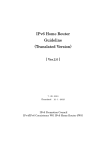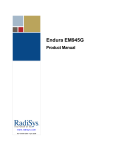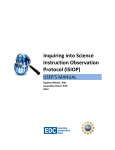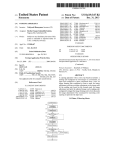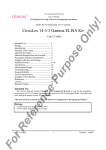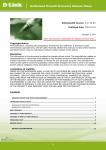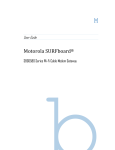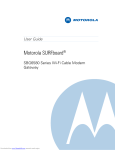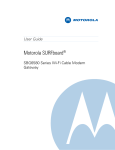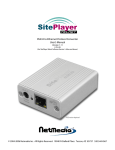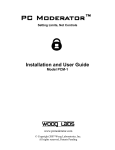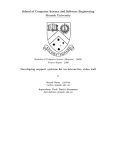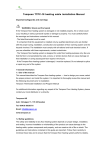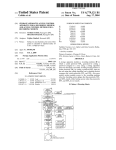Download IPv6 Home Router Guideline ( Ver.1.0 June 22 2009 )
Transcript
IPv6 Home Router
Guideline
(Translated Version)
[ Ver.1.0 ]
2009-06-22
IPv6 Promotion Council
IPv4/IPv6 Coexistence WG IPv6 Home Router SWG
Revision History
Ver.
Revised on:
Summary
0.9
2009-05-22
Public Comment Version
1.0
2009-06-22
Ver. 1.0
Some modification, unstudied items preparation
Acknowledgement
We would like to thank Yasuo Kashimura from
Alcatel Lucent in
translating the guideline document, which is
originally written in Japanese.
Original Guideline in Japanese is available at:
http://www.v6pc.jp/jp/upload/pdf/v6hgw_Guideline_1.0.pdf
Table of Contents
1
2
Introduction.................................................................................................................1
1.1
Background and Purpose of this Document ............................................................1
1.2
Environment Assumed and Readers Targeted by this Guideline..........................2
1.3
Glossary of Terms and Notation...............................................................................3
1.4
Preparation of Guideline ..........................................................................................4
1.4.1
Basic Functions Provided by ISP ......................................................................4
1.4.2
Home Network Summary ..................................................................................5
1.4.3
Functions Required of Home Router.................................................................6
Functions for Connecting to ISP .................................................................................9
2.1
Native Connection .....................................................................................................9
2.1.1
2.2
PPPoE/PPPoA............................................................................................................9
2.2.1
2.3
Connection Configuration ................................................................................10
Address Assignment Method .................................................................................... 11
3.1
Prefix Assignment ................................................................................................... 11
3.1.1
Prefix Information Distributed to a Home Network...................................... 11
3.1.2
Prefix Size Assigned to Home Network .......................................................... 11
3.1.3
Assignment of Prefix ........................................................................................12
3.2
WAN-side Address ...................................................................................................13
3.2.1
3.3
4
Connection Configuration ..................................................................................9
IP-based Tunnel (IPv6 over IPv4・IPv6 over IPv6 etc.) ......................................10
2.3.1
3
Connection Configuration ..................................................................................9
Allocation of Global Address ............................................................................13
LAN-side Address ....................................................................................................15
3.3.1
Prefix Re-distribution.......................................................................................15
3.3.2
Multiple Prefix Reception ................................................................................15
3.3.3
Change of Distributed Prefix ...........................................................................16
Access Control Function from Outside .....................................................................17
4.1
Access Control Function from Outside ..................................................................17
4.1.1
To Restrict Access from Outside ......................................................................17
4.1.2
Setting Criteria for Restricting Access from Outside ....................................18
4.2
Restricting Access to the Device Itself ...................................................................19
i
5
DNS Proxy/Resolver Function .................................................................................. 20
5.1
Assumptions ............................................................................................................20
5.2
Transport .................................................................................................................21
5.2.1
Usable Transport ..............................................................................................21
5.2.2
Prioritized Transport........................................................................................21
5.3
Type of Address with which DNS Proxy to Listen ................................................22
5.3.1
5.4
Selection Method when Multiple DNS Servers Exist...........................................23
5.4.1
Selection by Sequential Search Method .........................................................23
5.4.2
Arbitrary Selection Function ...........................................................................23
5.5
Cache ........................................................................................................................24
5.5.1
5.6
6
Cache Function .................................................................................................24
Resolver Function ...................................................................................................25
5.6.1
Supported Resource Record .............................................................................25
5.6.2
EDNS0...............................................................................................................25
5.6.3
TCP Port 53 Support ........................................................................................25
5.6.4
DNSSEC (Reference) ........................................................................................26
Information Distribution Function to Home network ..............................................27
6.1
Distributing Address/Prefix Information ..............................................................27
6.1.1
Distribution Using RA .....................................................................................27
6.1.2
Distribution Using DHCPv6 ............................................................................28
6.2
7
Type of Address with which DNS Proxy to Listen .........................................22
Distributing Server Information ............................................................................29
6.2.1
Distribution using RA ......................................................................................29
6.2.2
Distribution using DHCPv6 ............................................................................30
6.2.3
DHCPv6 Relay Function ..................................................................................30
Routing/Multicast Function ...................................................................................... 32
7.1
Handling Communications to Unused Address/Network ....................................32
7.2
Routing Information/Extension Header ................................................................33
7.2.1
Routing Control on WAN-side .........................................................................33
7.2.2
Route Control to LAN-side ..............................................................................34
7.2.3
Extension Header .............................................................................................35
7.3
IPv6 Multicast .........................................................................................................36
7.3.1
Function per IPv6 Multicast Connection Configuration ...............................36
7.3.2
Connection by PIM ...........................................................................................36
7.3.3
Connection by MLD Proxy ...............................................................................37
ii
7.3.4
8
Configuration Method on Service-side ......................................................................40
8.1
Configuration Method .............................................................................................40
8.1.1
Automatic Configuration .................................................................................40
8.1.2
Manual Configuration ......................................................................................42
8.2
9
MLD Snooping ..................................................................................................38
Configuration Items ................................................................................................43
8.2.1
Address Configuration .....................................................................................43
8.2.2
Security-related Configuration........................................................................43
8.2.3
DNS Configuration ...........................................................................................43
8.2.4
Home Network Configuration .........................................................................44
8.2.5
Routing/Multicast Configuration ....................................................................44
Conclusion ................................................................................................................. 45
9.1
Summary of Functions Required of IPv6 Home Router .......................................45
9.2
Study Items for Next Edition .................................................................................49
9.2.1
Items that Require Review/Detailed Studies .................................................49
9.2.2
Items Not Studied ............................................................................................49
9.3
Study Members .......................................................................................................51
9.4
Reference List ..........................................................................................................52
iii
1 Introduction
1.1
Background and Purpose of this Document
In recent years, the issue of IPv4 address exhaustion has always been on the agenda for
discussion, and network operators have naturally been expected to support IPv6 at an
early stage.
It was under these circumstances that, in September 2008, the IPv4/IPv6 Co-Existence
Working Group (WG) under the IPv6 Promotion Council1 set up the “IPv6 Home Router
Sub-Working Group (SWG).” 2 The purpose of this SWG is to bring together the
minimum common functions of the “Home Router” that are necessary for ISPs to
provide IPv6 Connection services, so that it becomes possible for Internet users to use
the IPv6 environment smoothly. “Minimum common functions” in this context means
that discussions were held not only from the viewpoint of Internet users, but also from
the viewpoints of Home Router-developing vendors and IPv6 connection service
providers.
This document summarizes the content of studies conducted so far at “IPv6 Home
Router SWG” in a tangible output titled “IPv6 Home Router Guideline.” Note that it has
no compelling force over Home Router implementation or ISP’s IPv6 service
specification.
1
2
IPv6 Promotion Council: http://www.v6pc.jp/
IPv6 Home Router SWG: http://www.v6pc.jp/jp/wg/coexistenceWG/v6hgw-swg.phtml
1
1.2
Environment Assumed and Readers Targeted by this
Guideline
This Guideline assumes an environment in which a home network is connected to an
ISP through a Home Router (compact router deployed inside a user’s home) as the
Internet connection topology. Also, as the IPv6 connection service assumes a dual-stack
environment, our studies should be conducted under the assumption that IPv4
equipment should communicate using IPv4. Further, those functions that become
necessary due to changes in the IPv4 environment, such as Large Scale NAT (LSN),
caused by IPv4 address exhaustion are also out of scope.
Examples of networks that are out of scope are listed below:
<Network Environment out of scope>
Enterprise networks
Public networks such as hot spots
Networks to which client terminals are directly connected
Networks in which middle boxes such as multi-stage NAT are also employed
The assumed IPv6 Home Router would have extensibility fully considered and possess
the minimum-required functions.
This Guideline is to be read primarily by the following readers:
People designing/developing a Home Router
People providing Internet connectivity services, such as those working for ISPs
2
1.3
Glossary of Terms and Notation
The terms used in this Guideline have the meanings defined in “IPv6-related Glossary”3
compiled by Internet Association Japan (IAjapan). For details, please refer to the
Glossary. Other terms not described in the Glossary are explained below:
Table 1-1
Explanation of Terms Used in This Guideline
Term
Description
ULA
Unique Local IPv6 Unicast Addresses. IPv6 unicast address
(RFC 4193)
defined for use in local communication such as within a site.
Equivalent to IPv4 private address (RFC 1918), it is specified
that part of the prefix should be generated randomly,
contributing to the enhanced uniqueness of an address.
TR-069
Technical Report 069. One of the technical specifications defined
by BroadBand Forum, it defines the application layer protocol
for remotely controlling CPE equipment. More specifically, it
defines communication between CPE and Auto Configuration
Server (ACS) using SOAP/HTTP [44].
UPnP
Universal Plug and Play. Generic term for the technical
specification defined by UPnP Forum with the purpose of
making it possible to join a network just by plugging in the
equipment. More specifically, it describes in XML such
information as how to control the behavior and functions of
equipment, with such information being communicated using
existing protocols such as SOAP/HTTP [45].
The expression “IPv4/IPv6” is used to communicate that there are both an IPv4 address
and an IPv6 address present. Also, “(Prefix length is) short/long” is used to represent a
comparison of IPv6 address prefix size, the definition of which is given below:
・Shorter than /35: means prefix length is shorter than 35 bits
E.g.)/32
Indicates, as prefix size, the address space is large
・Longer than /35: means prefix length is longer than 35 bits
E.g.)/64
Indicates, as prefix size, the address space is small
3
IPv6-related Glossary (IAJapan): http://www.iajapan.org/ipv6/v6term/glossary_01.html
3
1.4
Preparation of Guideline
This section gives an overview of the functions of the Home Router discussed in this
Guideline, and explains the structure of this Guideline.
1.4.1 Basic Functions Provided by ISP
An ISP’s IPv6 connection service model assumed in this Guideline can primarily be
categorized into the four functions shown in Figure 1-1:
Figure
1-1
Summary of ISP’s Service Model
・Prefix Assignment
In IPv6, unlike the IPv4 connection service, address assignment per prefix is
necessary. The assigned prefix size differs depending on the service, but is assumed
to be approximately between /64 and /48 of prefix length [8].
・Address Assignment
A case may be assumed in which the address is assigned from the ISP-side to the
WAN-side interface of the IPv6 Home Router for the purpose of monitoring if the
connection is dead or alive.
・Routing Information Distribution
Similar to the IPv4 case in principle, the default route is set from the ISP to the
4
user-side.
・Network Information Distribution
It is normal for server information provided by the ISP to the user not only to be
communicated as static text information but also distributed using DHCP etc.
Assuming an environment with the mechanism above, we tried to organize the
functions a Home Router needs.
1.4.2 Home Network Summary
A Home Router needs to re-distribute and assign information on each network (as
described earlier and provided by the ISP side) to the home network. This Guideline
discusses the following router functions regarding network setting for a home network.
Figure
1-2
Home Network Setting Overview
・Address/Prefix Assignment
Function for assigning prefix and address to the client terminal in the home LAN
using the address space assigned by the ISP-side. Various schemes can be
considered such as dynamic and static.
・Network Information Distribution
Function to distribute information about DNS server etc. to a client terminal.
5
Some standardized methods exist.
・Routing Information Distribution
Regarding routing information to a client terminal, a method that distributes only
the default route is considered normal.
・Access Control from Outside
In IPv6, similar to the IPv4 case, it is necessary to control communication to the
home. Especially in IPv6, as it is highly likely that a home network will be
configured with a global address, controlling access from outside is regarded to be
important.
・DNS Proxy/Resolver Function
Although it is possible to use the DNS server provided by an ISP directly from the
client terminal, a case can be assumed in which, similar to the IPv4 case, the DNS
function is there.
・Routing Control
Unlike the IPv4 case, proper implementation is needed given the fact that the
assigned address space is large and unused space may appear. Depending on the
service provided, a case in which implementation for multicast becomes necessary
can be assumed.
1.4.3
Functions Required of Home Router
Based on the services/functions listed in Sections 1.4.1 and 1.4.2, we sorted the
functions required for the Home Router discussed in this Guideline as shown in Table
1-2.
Table 1-2
List of Functions Required of Home Router
and Corresponding Chapter Numbers
Major Item
Medium Item
Chapter Number
Address/Prefix
Prefix Information Reception
3.1
Setting Function
Address/Prefix Information
3.3, 5.3, 6.1
Distribution
WAN-side Address Setting
3.2, 8.1.1
Routing Control
Routing Setting
7.2
Function
Not Reachable Address/Prefix Control
7.1
Multicast Function
7.3
Access Control
Access Control to Router Itself
4.2
Function
Access Control to Home Network
4.1, 7.2.3
6
Server Function
Control Rule Setting
4.1(4.1.2)
DNS Proxy Function
5.2, 5.3, 5.4, 5.5
DNS Resolver Function
5.6
Network Information Acquisition and
6.2, 8.2.4.2 , 8.2.4.3
Distribution
Setting Function of Router Itself
8.1, 8.2
In this Guideline, these functions are described in the following chapters.
In Chapter 2, we organize the functions that are necessary when connecting to the ISP
that provides an IPv6 connection service. Given that the format of the IPv6 connection
service provided by an ISP is unclear as of Fiscal Year 2008, we address only the IPv6
connection service format in this version.
In Chapter 3, we organize the functions focusing on use of the address space assigned by
ISP. Specifics about the protocols used are described in Chapter 6 and Chapter 8.
In Chapter 4, we summarize the necessary functions for access control from outside. As
end-to-end connection will be possible with IPv6, the importance of this function is
assumed to increase.
In Chapter 5, we summarize DNS service-related functions. Similar to the IPv4 case, we
organize the points requiring care when implementing DNS Proxy etc.
In Chapter 6, we organize things from the viewpoint of the home network setting.
In Chapter 7, we summarize routing information-related functions, and also discuss the
use of multicast.
In Chapter 8, we organize the necessary functions at the ISP side that provides the IPv6
connection service. As most of the functions will have already been summarized by then,
pointers are listed.
The functions required of the Home Router are organized as indicated above, and
detailed functions are organized according to the items listed in Table 1-3 to summarize
needs.
Table 1-3
Legend for Description of Detailed Functions (Minor Items)
Item
Meaning
Assumption:
Assumptions for the requirement discussed are described.
Requirement:
Overview of detailed functions required of Home Router is described.
Necessity:
The degree to which the requirement under discussion is required is
represented by: “Mandatory/Recommended/Optional.”
7
Mandatory (MUST): It is mandatory to implement the function.
Recommended (SHOULD): It is recommended to implement the
function.
Optional (MAY): Implementation is left up to the vendor because the
function may provide added value to the router (service-dependent
function etc.)
Reason:
Reasons that led us to consider the function listed as a requirement
are given.
Remarks:
Reference information etc. discussed before deciding necessity is
given.
8
2 Functions for Connecting to ISP
In this chapter, the purpose is to summarize the necessary connection functions when a
router uses an ISP service. Given that an ISP’s method of providing IPv6 network
reachability was unclear when conducting research for this Guideline, it is limited to
identifying what connection formats may exist. As a result, the functions required of a
home router are not defined in this chapter. Authentication technology in each
connection configuration is also out of scope.
2.1
Native Connection
2.1.1 Connection Configuration
Requirement: To provide IPv6network reachability via a native connection with no
tunnel termination at the Home Router
Figure 2-1
2.2
Native Connection
PPPoE/PPPoA
2.2.1 Connection Configuration
Requirement: To provide IPv6network reachability to a user’s home on PPP [1][2][3].
Figure 2-2
PPPoE/PPPoA Connection
9
2.3
IP-based Tunnel (IPv6 over IPv4・IPv6 over IPv6 etc.)
2.3.1 Connection Configuration
Requirement: To capsulate with IP and provide IPv6network reachability to a user’s
home [4][5][6][7].
Figure 2-3
IP-based Tunnel Connection
10
3 Address Assignment Method
In this chapter, various address assignment methods for a terminal to be connected to
the WAN-side, LAN-side, and LAN-side segments of a router are described.
3.1
Prefix Assignment
Router requirements when a service provider assigns a prefix to a user are described in
the following.
3.1.1 Prefix Information Distributed to a Home Network
Requirement: Router can obtain prefix information from connected ISP using
DHCPv6-PD.
Necessity:
Mandatory (MUST)
Reason: DHCPv6-PD is the standard protocol for performing IPv6 prefix assignment
automatically. Implementation is mandatory to eliminate configuration
errors due to manual inputting by a user.
Requirement: Manual configuration should be possible.
Necessity:
Mandatory (MUST)
Reason: Mandatory to respond to cases in which a connected ISP has no support for
prefix distribution using DHCPv6-PD.
3.1.2 Prefix Size Assigned to Home Network
Requirement: Router can receive the prefix assigned by service provider in the range
of /48 - /64.
Necessity:
Mandatory (MUST)
Reason: In “IPv6 Address Allocation and Assignment Policy at JPNIC” [8], as
assignment primarily of /48 - /64 is required to be done at the end site, the
ability to handle a prefix within this range is mandatory.
Remarks:
When considering separation of wireless/wired segments, or deployment of
DMZ, distribution of multiple segments (prefix length shorter than /64) is
desirable, but the assigned prefix size is to be decided by the service provider.
When considering SOHO etc., there is a possibility that a prefix length shorter
than /48 will be assigned.
11
3.1.3 Assignment of Prefix
The prefix distributed by a service provider to a user can be either assigned in a fixed
manner or vary with time.
Requirement: Prefix for distribution to user is fixed.
Necessity:
Recommended (SHOULD)
Reason: There are many limitations/constraints such as node requirements.
(re-numbering when a prefix is changed, level of ongoing communication to
be guaranteed during the change, etc., to achieve variable prefix
assignment) In the current situation, when considering stable operability of
user networks, fixed prefix assignment is more desirable than variable.
Hence, fixed assignment is recommended.
Remarks: Even if fixed assignment is the primary concern, considering privacy
concealment etc., responding to a prefix change request from the user side
should be possible.
Requirement: Prefix for distribution to user varies with time.
Necessity:
Optional (MAY)
Reason: Some people have the opinion that this is necessary to guarantee a user’s
communication privacy. In addition, in the current situation, non-fixed
assignment is the mainstream for IPv4 and a user might require an
equivalent function. However, given the issue that a user’s home equipment
can follow a prefix change when online, and given that operation of a Home
Router becomes complicated during a prefix change, this is treated as an
option in the current situation.
Remarks:
If a prefix is specified to be unfixed, the router should be able to detect a prefix
change (i.e., it should remember prefixes assigned in the past and function
properly when a change occurs). In addition, consideration needs to be given to
the handling of sessions during ongoing communication, and to support
re-numbering of a user’s home equipment during the change (also see 3.3.3).
Whether an address should be fixed or varied with time depends on the service
of the service provider; there are advantages and points for consideration with
each (see Table 3-1).
12
Table 3-1
Category
Fixed
Impact of Fixed/Unfixed Assigned Address
Specific Image
Occasion
Security/Privacy
Address changes
Case in which user
Operation and
User not subjected to
every time contract
changes contract from
management is easy
attack can have
with ISP is
ISP-A to ISP-B
advantages of fixed
terminated
address
Address changes
Case in which user
every time location
relocates home to
Privacy issue
is changed
another place
involved
Address changes
About once every
every time
several years, such as
operational event
ISP backbone design
happens
change etc.
Address changes
Case in which user
every time user
wants to change
makes a request
Possibility
User subjected
that all the
to attack can
address after
addresses in
avoid attack
experiencing DoS
a home may
change
attack
Unfixed
Address changes
Address changes every
every time
time Home Router or
connection is made
PC booted up (to a
- During link down
- During Home Router
replacement
degree not noticed by
the user)
3.2
WAN-side Address
In this section, address allocation to the WAN-side of a Home Router (link with service
provider) is described.
3.2.1 Allocation of Global Address
Requirement: Global address can be allocated to the WAN-side of Home Router. The
address to be allocated is not to be from the address space assigned to
the user, but rather from a different space owned by the service
provider.
Necessity:
Recommended (SHOULD)
Reason: Due to the service provider’s requirement for the ability to perform dead or
13
alive monitoring of a user, and to make it easier for the service provider to
implement a service on the router, allocation of the address to the WAN-side
of the Home Router should be possible.
Remarks:
Operation only with a link local address, without allocation of a global address,
can also be considered.
Given that use by the service provider is assumed, it is desirable that the
service provider assigns it not from the user-assigned space but rather from a
different one. However, if an address managed by the service provider is
allocated, it could be beyond user management (beyond recognition). If this
address is not managed properly, a security issue may arise, such as allowing
unauthorized access to the address that is not expected by the user.
3.2.1.1
Global Address Allocation Method (Automatic)
Assumption:
For a case in which global address is allocated to the WAN-side.
Requirement: Global address can be allocated automatically to the WAN-side
interface.
Necessity:
Mandatory (MUST)
Reason: This is mandatory to achieve automatic setting with no user intervention.
Either of the methods below is mandatory:
[a] SLAAC (Stateless Address Auto Configuration)
[b] DHCPv6
Remarks:
When using SLAAC, unless in combination with a separate mechanism for
informing the configured address (DDNS etc.), the service provider will not be
able to know the allocated address.
For method selection, technical trends (as of April 2009, in DHCPv6, prefix
length distribution needs to be used in combination with a separate router
advertisement/prefix option etc.), need to be considered. The fact that, in an
IPv6 global unicast address, the interface identifier is specified as 64-bit length
[46] and should balance with other requirements (address prefix size to be
assigned to WAN-side, and issues that might arise (Section 7.1)) also need to be
considered.
3.2.1.2
Global Address Allocation Method (Manual)
Assumption:
For a case in which a global address is allocated to the WAN-side.
Requirement: Global address can be allocated manually to the WAN-side interface.
14
Necessity:
Mandatory (MUST)
Reason: Although automatic configuration is a prerequisite, manual configuration is
also necessary.
3.3
LAN-side Address
In this section, address allocation to the LAN-side of the Home Router (link with user’s
home network) is described.
3.3.1 Prefix Re-distribution
Requirement: On basis of a prefix received using DHCPv6-PD from ISP, the router
can generate a /64 prefix and re-distribute it to the LAN-side.
Necessity:
Mandatory (MUST)
Reason: A method to automatically re-distribute a prefix distributed to a user’s home
equipment by the ISP is mandatory.
Remarks:
With regard to the protocol for re-distribution, see Section 6.1.
The method for deciding the /64 prefix if a prefix larger than /64 has been
received using DHCPv6-PD is not specified. For example, if a /48 prefix has
been received using DHCPv6-PD, it is necessary to decide the value within the
range of 49 to 64 bits when re-distributing to the LAN-side. The method for
making this decision can be implementation-dependent; it is not specified in
this document.
3.3.2 Multiple Prefix Reception
Requirement: Multiple prefixes have been received using DHCPv6-PD from one or
more ISPs, and the router can select which prefix is to be
re-distributed to the LAN-side.
Necessity:
Optional (MAY)
Reason: This function supports environments where a number of upstream ISPs
exist and where the ISP may distribute a number of different prefixes.
Because an environment with a number of upstream ISPs is considered to
be exceptional for a Home Router, this should be treated as optional.
Remarks:
A connection service whereby distribution of one each of a fixed prefix and a
dynamic prefix is assumed.
Fixed prefix and dynamic prefixes each have their own advantages, so it is
15
desirable for a user to be able to select either.
Although a case can be anticipated in which access to a specific network may
become impossible after having selected a prefix of either type, that kind of
prefix is not specified in this document.
3.3.3 Change of Distributed Prefix
Assumption:
The case of a service whereby a user-assigned prefix is varied with
time.
Requirement: In case the prefix distributed using DHCPv6-PD by ISP changes due
to re-connection of the WAN-side connection, changing the prefix to be
distributed to the LAN-side properly should be possible.
Necessity:
Recommended (SHOULD)
Reason: In case a service whereby a user-assigned prefix is varied with time is
selected,
it
is
necessary
to
minimize
the
effects
of
a
service-provider-initiated change of prefix on communication in a user
network. As the situation is unclear regarding support provided by home
equipment for a change of prefix, this should be treated as a recommended
function.
Remarks: Many specific methods are specified (see Sections 3.1.3 and 6.1.2).
16
4 Access Control Function from Outside
In this chapter, the access control mechanism that is considered to be the minimum
requirement for protecting the user home network is described. As a precondition,
security functions employed for IPv4 (including the point at which direct reachability
from an outside network to the home network is lost due to NAT/NAPT) should also be
necessary for an IPv6 Home Router.
4.1
Access Control Function from Outside
4.1.1 To Restrict Access from Outside
4.1.1.1
Basic Setting for Access Restriction
Requirement: Router can perform access restriction at a point where there is
communication from inside (LAN-side) to outside (WAN-side), while
communication from outside to inside is dropped.
Necessity:
Mandatory (MUST)
Reason: Access control equivalent to the initial behavior of the current IPv4 Home
Router is considered to be mandatory.
Remarks: Although the default behavior is to restrict communication from outside to
inside, it is also necessary to have that communication by setting it at the
same time (see also Section 4.1.2).
Figure 4-1
Access Control from Outside Function
17
4.1.1.2
Detailed Setting of Access Restriction
Requirement: Router can restrict access with static filter.
Traffic is passed through by default from inside to outside.
For TCP, SYN from outside to inside is dropped by default.
For UDP, only specific protocols from outside to inside are allowed through,
while other protocols are dropped by default.
Specific protocol: DNS or other service-dependent mandatory protocols (TV,
telephony etc.).
For ICMPv6, only a mandatory message [9] from outside to inside is allowed
through, while others are dropped by default.
Necessity:
Mandatory (MUST)
Reason: Maintaining the minimum network security level considered necessary in
IPv6 is mandatory.
Remarks:
There are cases in which control of traffic from the inside will be necessary
from a security viewpoint. For example, communication with a source address
other than the address assigned by the service provider may be restricted.
Access control must be implemented with consideration given to the
re-configuration of fragmented packets.
4.1.1.3
Extended Functions of Access Restriction
Requirement: Router can restrict access with a dynamic filter (SPI).
Traffic passes through by default from inside to outside.
Connections through which communications took place from inside to outside
should be remembered, and for these connections, traffic passes through from
outside to inside.
Necessity:
Recommended (SHOULD)
Reason:
Because this is also an important function to maintain a security level
equivalent to the current IPv4 NAT in IPv6 as well, this should be treated as
Recommended.
With regard to SPI, also see the descriptions of RFC 4787 [47].
4.1.2 Setting Criteria for Restricting Access from Outside
Requirement: Router can have criteria on the basis of which access from outside is
passed through or dropped.
18
Necessity:
Mandatory (MUST)
Function
Necessity
Router can restrict access by IPv6 source/destination address.
Mandatory
(MUST)
Router can recognize the next header (protocol)
Mandatory
(See Section 7.2.3)
(MUST)
Router can restrict access by protocol type
Recommended
(extended header type etc.)
(SHOULD)
Router can trace the next header chain
Mandatory
(MUST)
Router can restrict access by ICMP Type and Code [9]
Recommended
(SHOULD)
Router can restrict access by TCP/UDP source/destination port
Mandatory
number
(MUST)
Reason: To maintain the security level of the current IPv4 network in IPv6 as well
[10].
Remarks: When tracing the next header chain, the degree of depth to which it needs
to be traced is implementation-dependent (Currently, there is no
specification).
4.2
Restricting Access to the Device Itself
Requirement: Access control of communications to the device itself is possible.
Necessity:
Mandatory (MUST)
Reason: Achieving security for service functions provided by equipment itself as an
IPv6 host is necessary.
19
5 DNS Proxy/Resolver Function
In this chapter, the DNS Proxy function that is implemented in many current IPv4
Home Routers and other DNS-related functions such as Resolver function are described.
Also see [14].
5.1
Assumptions
Figure
5-1
DNS Proxy/Resolver Function Concept Figure
Reason for DNS Proxy/Resolver Needed
Benefits of Implementation
DNS server load mitigation (when using cache)
In an environment with no upstream connection, setting the DNS server to the
client will be possible.
Local name resolution will be possible.
Drawbacks of Non-implementation
Due to incorrect selection of DNS server at the terminal side, it is possible for
problems such as a delay or communication failure to occur.
For access to Web-GUI, direct input of IP address will be necessary instead of
FQDN (User convenience lowered). ※Input of IPv6 address will be difficult
http://web.setup/ → http://[2001:db8::1]/
Assumptions for Implementing DNS Proxy/Resolver Functions
The principle is to handle a request from a terminal transparently.
In case a conversion process such as translator or ALG is involved, because this
function will be in the functional domain of translator or ALG, it is outside the
scope of our current studies.
In case the conversion process above is involved due to implementation at the DNS
20
side, independent studies will be necessary because there is a risk that a terminal
may get an unintended query result.
DNS Resolver part is described as an item that should be considered regardless of
IPv4 or IPv6.
5.2
Transport
Figure
5-2
Selection of Used Transport
5.2.1 Usable Transport
Requirement: At the upstream side of DNS Proxy (DNS server-side of ISP), both
IPv6 transport and IPv4 transport can be usable.
Necessity:
Mandatory (MUST)
Reason: To be able to support both cases when the DNS server address specified by
ISP etc. may be either IPv4 or IPv6.
5.2.2 Prioritized Transport
Requirement: Proxy operation can be performed with the same transport as a DNS
request from a terminal.
Necessity:
Optional (MAY)
Reason: Because there is a possibility that, due to a change of transport, the
requesting terminal may not be able to get the expected result [15].
Remarks: The reason why Proxy operation with the same transport is not
MUST/SHOULD but MAY is because it will be necessary to change
transport if there is a cache server beyond a Home Router (DNS Proxy).
For example, in case even if the query from a terminal to the DNS Proxy is
made with IPv6 transport, a cache server supports IPv4 transport only, so
the DNS Proxy will need a transport conversion function.
21
When performing a Proxy operation with the same transport, the DNS
Proxy will need the function to remember the transport requested by the
terminal.
As there is an operation in the IPv4 Internet whereby a reply from the
DNS server may differ depending on the query source address, alignment
of transport does not necessarily get us the same reply. Nevertheless, it is
recommended that transport be aligned in terms of probability.
5.3
Type of Address with which DNS Proxy to Listen
Figure
5-3
Type of Address to listen
5.3.1 Type of Address with which DNS Proxy to Listen
Requirement: Router can listen with a unicast address (any global address, ULA, or
link local address).
Necessity:
Mandatory (MUST)
Reason: It is necessary to be able to listen with a unicast address at a minimum.
Remarks: When listening with ULA, the DNS Proxy needs to have defined the ULA
to be used in advance. Further, when the ULA was already in use on the
LAN, a mechanism to generate another ULA that does not conflict will be
necessary.
When the DNS Proxy listens for a query with an ULA, implementation is
allowed whereby it is not shown to the outside as an interface and reply is
possible only from inside.
When the DNS Proxy listens for a query with a global address, a situation may
exist in which no global address is assigned to the DNS Proxy, such as during
upstream connection failure or when setup is not complete. In this case,
attention is required as a query packet cannot reach the DNS Proxy.
22
Further, in order not to become a DNS Open Resolver that may serve as a
factor in a DNS amplified attack, consideration such as not accepting queries
from the WAN-side is required.
When the DNS Proxy listens for a query with a link local address, queries from
other segments cannot reach the DNS Proxy. Moreover, as it is possible for
problems to exist, such as a terminal Resolver not being able to specify link
local address etc., attention is required.
Also, implementing DNS (RFC 4795) [53] can also be considered.
5.4
Selection Method when Multiple DNS Servers Exist
Figure
5-4
Selection of DNS Server
5.4.1 Selection by Sequential Search Method
Requirement: Router can use multiple DNS servers and perform DNS selection by
Sequential Search Method.
Necessity:
Mandatory (MUST)
Reason: To increase reachability to communication destination.
5.4.2 Arbitrary Selection Function
Requirement: In case there is any function such as Domain Identification Method
whereby a DNS server is selected arbitrarily according to a specific
policy, the rules set by such function should be followed.
Necessity:
Optional (MAY)
Reason: To prioritize the intention of user or ISP.
Remarks:
Although both Sequential Search Method and Domain Identification Method
23
can be a solution for the DNS server selection issue per service network in a
multi-prefix
environment,
they
cannot
solve
all
related
problems.
Implementation should be done after evaluating benefits and drawbacks
[16][17].
There is no specification regarding priority for the case in which the DNS
server exists respectively for IPv6 transport and IPv4 transport.
There are different opinions such as IPv4 should be used because there is
concern about the current IPv6 DNS server, or IPv6 should be used considering
migration to IPv6 in the near future. Opinions are divided and this is an issue
for further study.
Among Resolvers of various OS’s, there are many that prioritize IPv6.
In DNS, the assumption is that the same reply should be made regardless of
transport.
5.5
Cache
5.5.1 Cache Function
Requirement: The results obtained by a DNS request from a terminal should be
cached, and such cached information should be returned in
subsequent and similar DNS requests.
Necessity:
Optional (MAY)
Reason: Because ISP’s DNS server load mitigation (suppression of request/reply
packet) is possible.
Remarks: As a prompt response will be required in case a DNS-related vulnerability
such as a Kaminsky Attack [18] is found, implementation needs to be done
after evaluating benefits and drawbacks.
Figure
5-5
DNS Cache Function
24
5.6
Resolver Function
Although the following functions required of a Resolver are not IPv6-specific, they are
more relevant than in IPv4. Hence, it is recommended that they are considered to be
part of the specification to be implemented in a Home Router.
Figure
5-6
DNS Resolver Function
5.6.1 Supported Resource Record
Requirement: DNS request from a terminal should all be processed transparently
regardless of resource record (RR) type.
Necessity:
Mandatory (MUST)
Reason: Because the requesting terminal cannot get the expected result if RR type is
limited.
5.6.2 EDNS0
Requirement: Router can process EDNS0[19]-supported request (including OPT RR)
packet transparently, and send a reply exceeding 512 bytes to a
terminal.
Necessity:
Mandatory (MUST)
Reason: Because situations are arising in which a DNS reply packet exceeds 512
bytes, due to use of AAAA or PTR, SPF, SRV, TXT, DNSSEC etc.
5.6.3 TCP Port 53 Support
Requirement: In case the terminal (after receiving DNS Header TC=1 [20][21]) falls
back to TCP connection, the DNS request can be processed
transparently.
Listening not only at UDP Port 53 but also at TCP Port 53.
25
Necessity:
Mandatory (MUST)
Reason: In order not to impact the DNS request-related behavior of a terminal.
5.6.4 DNSSEC (Reference)
Requirement: Router can process the following packets that support DNSSEC
transparently or properly [22][23][24].
EDNS0 (OPT RR) DO bit set.
RRSIG, DNSKEY, DS, NSEC, NSEC3, NSEC3PARAM RR used.
For DNS Header Bit, CD (checking disabled) or AD (authentic data) is
used.
Necessity:
Optional (MAY)
Reason: In order not to impact the DNS request-related behavior of a terminal.
Remarks: Currently, this is not implemented in Windows XP or Windows Vista;
Urgency seems to be not so great. As DNSSEC implementation is planned
for Windows 7, and use in combination with IPSec is assumed, it may
become necessary to look into IPsec support [25].
As a Home Router’s DNS Proxy/Resolver function, whether to implement
recursion process including signature verification, or to operate as
single-function
Proxy
with
implementation-dependent.
26
IP
address
conversion
only
is
6 Information Distribution Function to Home network
In this chapter, the distribution method of address/prefix information and server
information from the Home Router to the home terminal are described.
6.1
Distributing Address/Prefix Information
6.1.1 Distribution Using RA
Requirement: Router has a function to inform by RA the prefix to be assigned to
home network terminal.
Necessity:
Mandatory (MUST)
Reason: This function is mandatory for an IPv6 router [28].
Remarks: For distribution policy within LAN in case multiple prefix has been
obtained from ISP etc., see Section 3.3.2.
Figure
6-1
Distribution of Prefix Information Using RA
Requirement: Prefix length informed by RA should be /64 by default.
Necessity:
Mandatory (MUST)
Reason: Because many implementations have the last 64 bit of the address as the
interface ID in a stateless address automatic configuration in the terminal.
Remarks: Take note of the fact that, when distribution is done with a prefix length
other than /64, there are cases in which the address does not get set
properly to equipment in a LAN. For example, address generation cannot
be done with a prefix other than /64 in Windows Vista SP1.
In SLAAC (RFC 4862) specification, it is specified that, in case the sum of
the prefix length in the Prefix Information Option of RA and interface ID
27
length held by the node itself is not 128, the Prefix Information Option is
ignored (MUST) [29][48].
6.1.2 Distribution Using DHCPv6
Requirement: Router has a function to inform an address to a home terminal by
DHCPv6 [27].
Necessity:
Optional (MAY)
Reason: Because it is effective when assigning a specific address to a home network
terminal.
Figure
6-2
Distribution of Address Information by DHCPv6
Requirement: There should be a function for distributing a prefix to home equipment
(router) by DHCPv6-PD [30]. There should be a function that enables
specification of the prefix to be distributed per equipment.
Necessity:
Optional (MAY)
Reason: In case multiple routers exist at a home, to distribute the prefix to be
assigned to the terminal connected to the relevant router.
28
Figure
6.2
6-3
Distribution of Prefix Information by DHCPv6-PD
Distributing Server Information
6.2.1 Distribution using RA
Requirement: Router has a function for distributing DNS server address to the LAN
segment.
Necessity:
Optional (MAY)
Reason: Because implementation [31] to get a DNS server information from RA is
expected at a terminal.
Figure
6-4
Distribution of Server Information by RA
29
6.2.2 Distribution using DHCPv6
Requirement: Router has a function for distributing DNS server address by DHCPv6
to a LAN segment.
Necessity:
Mandatory (MUST)
Reason: Because the method to get DNS server information by DHCPv6 is common
with implementation at the terminal side.
Remarks: With standardization, DHCPv6 is Standard Track (RFC 3646), while RA is
Experimental (RFC 5006) [32].
Requirement: Router has a function for distributing other server addresses (SIP,
NTP etc.) by DHCPv6 to a LAN segment.
Necessity:
Optional (MAY)
Reason: To automatically set to the terminal the server information required for a
user to use various services.
Remarks: Which server address is to be distributed depends on the specification of
an ISP’s service.
Server address distributable by DHCPv6:
SIP server [49], DNS server [50], NIS server [51], SNTP server [52] etc.
DHCPv6 parameter list:
http://www.iana.org/assignments/dhcpv6-parameters/
DHCPv6
- 2001:DB8:1:1::53
- 2001:DB8:1:1::123
- 2001:DB8:1:1::5060
Sample Server Addresses
DNS
2001:DB8:1:1::53
SNTP
2001:DB8:1:1::123
SIP
2001:DB8:1:1::5060
Figure
6-5
Distribution of Server Information by DHCPv6
6.2.3 DHCPv6 Relay Function
Requirement: Router has a DHCPv6 Relay function.
Necessity:
Optional (MAY)
30
Reason: Because the case in which an ISP manages a home network setting is
anticipated.
Remarks: DHCPv6 server function and DHCPv6 relay function are not concurrently
used on same equipment.
When the DHCPv6 Relay function is enabled, the DHCPv6 Server function
should be disabled (In case the DHCPv6 Server function has been
implemented).
When the DHCPv6 Server function is enabled, the DHCPv6 Relay function
should be disabled.
Figure
6-6
DHCPv6 Relay Function
31
7 Routing/Multicast Function
In this chapter, the minimum-required routing function/multicast function for the Home
Router to get connected to a service using IPv6 is described.
7.1
Handling Communications to Unused Address/Network
Assumption:
Service to perform address assignment by DHCPv6-PD.
Requirement: Router has a function not to forward traffic addressed to the assigned
prefix upstream.
Necessity:
Mandatory (MUST)
Reason: If packets addressed to an unused address space are forwarded to a default
route, such packets get ping-ponged between a Home Router and an ISP
router until TTL gets to 0. This ping-pong behavior should be prevented.
Prefix delegation
Destination
2001:DB8:1::/48
2001:DB8:1::/48
2001:DB8:1:1::/64
Figure
Assumption:
7-1
The Service To Do Address Assignment by DHCPv6-PD
Service to perform connection with the WAN-side as a Point-to-Point
link.
Requirement: When the router receives packets for an address other than own
interface address on a Point-to-Point link, ICMPv6 Destination
Unreachable messages, Code 3 (Address unreachable) should be sent
out, and packets should not be forwarded [33].
Necessity:
Mandatory (MUST)
Reason: To prevent packets from getting ping-ponged between Home Router and ISP
Router until TTL gets to 0.
32
:2
Destination
2001:DB8::/64
ICMPv6 Destination
2001:DB8::3/64
:1
Unreachable messages
Figure
7.2
7-2
Service To Connect with WAN-side as a Point-to-Point Link
Routing Information/Extension Header
7.2.1 Routing Control on WAN-side
Requirement: Static route for WAN-side can be configured.
Necessity:
Mandatory (MUST)
Reason: Because at least the function for explicitly setting a default route etc. in a
router is required.
Remarks: Because the ICMPv6 redirect function will not work properly if a link local
address cannot be specified to the next hop address, it is also necessary to
be able to specify the link local address.
:2
2001:DB8::/6
::/0 via
4
Figure
:1
7-3
2001:DB8::1
Static Route Setting for WAN-side
Requirement: Automatic configuration of default route using RA should be possible.
33
Necessity:
Mandatory (MUST)
Reason: Because consideration is necessary for a service whereby IPv6 address is
configured by RA.
Remarks: Although a router in general does not support automatic configuration of a
route by RA, it is important for a Home Router to perform setting for a
service provider without the user’s manual intervention [48]. Also, when
multiple WAN interfaces exist and multiple RA’s are received, attention is
called for as it is necessary to decide which default route should be
prioritized. This should be treated as an item for further study (see Section
9.2).
:1
R1
::/0 via R1
Figure
7-4
Automatic Configuration of Default Route Using RA
7.2.2 Route Control to LAN-side
Requirement: Route distribution to the LAN-side by RIPng [34] is possible.
Necessity:
Optional (MAY)
Reason: Because its use is anticipated when controlling the route to the network
connected to a router’s LAN side.
34
2001:DB8:1:1::/64
R1
2001:DB8:1:3::/64
via R2
2001:DB8:1:1::/64
via R1
2001:DB8:1:2::/64
::/0 via R1
R2
Figure
7-5
Route Control by RIPng
Requirement: It is possible to distribute a route to the LAN-side by More-Specific
Routes [35].
Necessity:
Optional (MAY)
Reason: Because its use is anticipated when controlling routes to a network
connected to a router’s LAN-side.
2001:DB8:1:1::/64
R1
Route information option
2001:DB8:1:3::/64
2001:DB8:1:2::/64
R2
2001:DB8:1:3::/64
Figure
7-6
Use of More-Specific Route
7.2.3 Extension Header
Requirement: It is possible to prohibit RH0 (Type 0 routing headers) packet
forwarding.
Necessity:
Mandatory (MUST)
35
Reason: Because consideration of a DoS attack by IPv6 source routing [11] is
necessary, and its use is prohibited in the current specification.
Remarks: Rather than implementation whereby routing header is completely
prohibited, it is necessary to be able to look at the type accurately and
prohibit Type 0 only.
RH0
Figure
7.3
7-7
RH0 Packet Forwarding Prohibited
IPv6 Multicast
Because a Home Router’s support for the IPv6 Multicast function largely depends on an
ISP’s service, the overall function should be treated as Optional (MAY).
7.3.1 Function per IPv6 Multicast Connection Configuration
For connection to an IPv6 multicast service, two connection patterns can be considered
depending on the protocol used upstream from a Home Router (to WAN-side). The
functions required for each connection configuration are shown below.
7.3.2 Connection by PIM
Join/Leave for Multicast group is informed to ISP using PIM.
36
PIM Join
MLD Report
Figure
Assumption:
7-8
Multicast Connection Using PIM
The case of connecting to Multicast service by PIM
Requirement: Router has Multicast routing function by PIM [36][37][38].
Necessity:
Mandatory (MUST)
Reason: To support services using PIM as the WAN-side protocol.
Remarks: Many optional functions exist in the specification of PIM-SM/SSM, and
depending on the implementation status of equipment, problems may
occur in terms of inter-operability. Due to this, care should be taken during
implementation. This is treated as an item for further study (See Section
9.2).
Assumption:
The case of connecting to Multicast service using PIM.
Requirement: Router has MLD (v1/v2) router function [39][40][41].
Necessity:
Mandatory (MUST)
Reason: Because support for MLD router function is necessary for terminal to
participate in a Multicast network during PIM connection.
7.3.3 Connection by MLD Proxy
Join/Leave Multicast group is informed to ISP using MLD.
37
MLD Report
MLD Report
Figure
Assumption:
7-9
Multicast Connection Using MLD Proxy
Case of connecting to Multicast service using MLD Proxy.
Requirement: Router has MLD (v1/v2) Proxy [42] function.
Necessity:
Mandatory (MUST)
Reason: To inform Join/Leave Multicast group to ISP-side by MLD.
7.3.4 MLD Snooping
In any of the connection configurations described in Section 7.3.1, it is desirable to
implement the following MLD snooping [43] function as well if a Home Router has a
switch function. Also, if a Home Router has a wireless LAN function, it is desirable to
have a function equivalent to MLD snooping that restricts the flow of unnecessary
Multicast traffic to a wireless LAN-connected node.
Requirement: Router has MLD (v1/v2) snooping [43] function.
Necessity:
Optional (MAY)
Reason: Because its use is anticipated only when a router has a switching function.
38
FF04::12
Figure
7-10
MLD Snooping Function
39
8 Configuration Method on Service-side
In this chapter, the configuration method and items to be configured for a Home Router
are described. Note that the agent who does the setting is the service provider.
8.1
Configuration Method
Overview:
A Home Router is equipped with a function for the service provider to
feed the necessary setting to it.
Necessity:
Mandatory (MUST)
Reason: Because users who are not familiar with the security configuration can get a
service with a certain level of security.
Remarks: Specific setting methods are listed with examples below.
8.1.1 Automatic Configuration
In this section, the method whereby a Home Router gets the necessary setting
information autonomously, with no direct operation of a Home Router by the service
provider, is listed with examples below.
Router has SLAAC function.
Method of setting an IPv6 address by RA without using a DHCPv6 server.
Figure
8-1
Automatic Configuration by SLAAC
40
Router has DHCPv6 client function.
DHCPv6 client function is a function for requesting information such as IPv6
address to a DHCPv6 server and configuring the information obtained to become a
host.
Figure
8-2
Address Configuration by DHCPv6
Router can use TR-069 for address configuration.
Setting method using TR-069: protocol for remotely controlling CPE defined by
BroadBand Forum.
Figure
8-3
Address Configuration by TR-069
41
Router can be configured by UPnP.
Method of configuring an address using UPnP: automatic equipment registration
mechanism defined by UPnP Forum.
Figure
8-4
Address Configuration by UPnP
8.1.2 Manual Configuration
Because a case is anticipated in which a service provider manually sets a Home Router
directly, the interface for that needs to be implemented. Specifically, Web interface or
telnet, ssh etc. will be used.
Figure
8-5
Manual Configuration Concept Figure
42
8.2
Configuration Items
In this section, specific items to be configured for a Home Router by the configuring
methods mentioned in Section 8.1 are described.
8.2.1 Address Configuration
See Chapter 3.
8.2.2 Security-related Configuration
Requirement: It should be possible for a user to make setting changes to the Access
Restricting function of equipment directly, and, setting should also be
possible from the operator-side such as the ISP.
Necessity:
Recommended(SHOULD)
Reason: To enable services to be provided whereby even users not familiar with
security setting can maintain the necessary security level while being
serviced.
Remarks: Because this is a service-dependent function, it should be possible for the
user to disable the function when it is not being used.
Requirement: There should be means for accessing a Home Router’s administration
interface from an ISP’s administration segment at the WAN
interface-side.
Necessity:
Optional (MAY)
Reason: To restrict unauthorized access from outside when a global address is
assigned and monitored.
8.2.3 DNS Configuration
In this section, the method of configuring a DNS server address for a Home Router if the
Home Router uses a DNS Proxy function is described. For other items, see Chapter 5.
8.2.3.1
DNS Server Address for DNS Proxy Function
Requirement: Router can use DNS server information obtained through means such
as DHCPv6.
Necessity:
Mandatory (MUST)
Reason: To eliminate setting errors by automation.
Requirement: Manual setting is possible.
Necessity:
Mandatory (MUST)
43
Reason: Because there may be a case in which automatic configuration by an ISP is
not possible.
8.2.4 Home Network Configuration
In this section, the method of configuring necessary information when a Home Router
performs setting for Home equipment is described.
8.2.4.1
Prefix Distributed to LAN-side
See Chapter 3.
8.2.4.2
Various Server Address Distributed to LAN-side
Requirement: Router can get it from the connected ISP by DHCPv6.
Necessity:
Mandatory (MUST)
Reason: Because it is generally the case that a variety of server information
distributed to a router differs depending on the service provided, and a
method that enables selective distribution of necessary information is
desirable.
Requirement: Manual setting is possible.
Necessity:
Mandatory (MUST)
Reason: Because there may be a case in which automatic configuration by an ISP is
not possible.
8.2.4.3
DHCPv6 Server Address for DHCPv6 Relay Function
Assumption:
Case using DHCPv6 Relay function
Requirement: Manual setting is possible.
Necessity:
Mandatory (MUST)
Reason: Because an automatic method for assigning a DHCPv6 server address is not
provided.
Remarks: By making Multicast routing work between the DHCPv6 server and a
Home Router, it is also possible to make explicitly setting the DHCPv6
server address unnecessary.
8.2.5 Routing/Multicast Configuration
See Chapter 7.
44
9 Conclusion
9.1
Summary of Functions Required of IPv6 Home Router
“Minimum-required Common Functions for IPv6 Home Router” described up to the
preceding chapter are summarized in Table 9-1. Although this Guideline does not
cover all the functions of the IPv6 Home Router, implementation considering at least
the functions listed here is desired for an IPv6 Home Router. Note that items not
studied and treated for further discussion are summarized in the next section (Section
9.2).
Table
9-1
List of Functions Needed for IPv6 Home Router
Num
Minor Item
Necessity
Section
1
It is possible to get prefix information distributed
Mandatory
3.1.1
Mandatory
3.1.1
Mandatory
3.1.2
to a home network from the connected ISP using
DHCPv6-PD.
2
Manual setting of prefix information distributed
to a home network is possible.
3
It is possible to receive the prefix assigned by
service provider in the range of /48~/64.
4
Prefix for distribution to user is fixed.
Recommended
3.1.3
5
Prefix for distribution to user varies with time.
Optional
3.1.3
6
It is possible to allocate a global address to the
Recommended
3.2.1
Mandatory
3.2.1.1
Mandatory
3.2.1.2
Mandatory
3.3.1
Optional
3.3.2
WAN-side of a Home Router. The address to be
allocated is not from the address space assigned to
user, but rather from a different space owned by
the service provider.
7
8
9
Assumption
It is possible to allocate WAN-side
6
global address dynamically.
Assumption
It is possible to allocate WAN-side
6
global address manually.
Based on the prefix received using DHCPv6-PD
from ISP, it is possible to generate /64 prefix and
re-distribute it to the LAN-side.
10
In case multiple prefixes have been received using
45
DHCPv6-PD from one or multiple ISPs, it is
possible to select which prefix to re-distribute to
the LAN-side.
11
Assumption
In case the prefix distributed using
5
DHCPv6-PD by an ISP changes due
Recommended
3.3.3
Mandatory
4.1.1.1
to re-connection of the WAN-side
connection, it is possible to change
the prefix to be distributed to the
LAN-side properly.
12
It is possible to restrict access where there is
communication from inside (LAN-side) to outside
(WAN-side), while communication from outside to
inside is restricted by default.
13
It is possible to restrict access with a static filter.
Mandatory
4.1.1.2
14
It is possible to restrict access with a dynamic
Recommended
4.1.1.3
Mandatory
4.1.2
Mandatory
4.2
Mandatory
5.2.1
Optional
5.2.2
Mandatory
5.3.1
Mandatory
5.4.1
Optional
5.4.2
Optional
5.5
filter (SPI).
15
It is possible to set up criteria by which access
from outside is allowed or restricted.
16
It is possible to set up a filter to control access of
communications to the router itself.
17
At the upstream side of DNS Proxy (DNS
server-side of ISP), both IPv6 transport and IPv4
transport are usable.
18
Proxy operation is performed with the same
transport as DNS request from terminal.
19
For DNS Proxy, listen for unicast address (any
global address, ULA, or link local address) is
possible.
20
It is possible to use multiple DNS servers, and
perform DNS selection by Sequential Search
Method.
21
In case there is any function such as Domain
Identification Method whereby a DNS server is
selected arbitrarily according to a specific policy,
the rules set by such function are followed.
22
The results obtained by a DNS request from
46
terminal are cached, and such cached information
is returned in a subsequent and similar DNS
request.
23
DNS
request
from
terminal
is
processed
Mandatory
5.6.1
Mandatory
5.6.2
Mandatory
5.6.3
Optional
5.6.4
Mandatory
6.1.1
transparently regardless of resource record (RR)
type.
24
It is possible to process an EDNS0-supported
request (including OPT RR) packet transparently,
and send a reply exceeding 512 bytes to terminal.
25
The case in which terminal (after receiving DNS
Header TC=1) does fallback to TCP connection
and
makes
a
transparently.
DNS
request
is
processed
Listening should be performed
not only at UDP Port 53 but also at TCP Port 53.
26
It is possible to process the following packets that
support DNSSEC transparently or properly.
27
It has a function to inform the prefix to be
assigned to a home network terminal by RA.
28
Prefix length informed by RA is /64 by default.
Mandatory
6.1.1
29
It has a function to inform an address to a home
Optional
6.1.2
Optional
6.1.2
Optional
6.2.1
Mandatory
6.2.2
Optional
6.2.2
terminal by DHCPv6.
30
It has a function for distributing a prefix to home
equipment (router) by DHCPv6-PD.
It has a
function that enables the prefix distributed to be
specified per item of equipment.
31
It has a function for distributing a DNS server
address to a LAN segment.
32
It has a function for distributing a DNS server
address by DHCPv6 to a LAN segment.
33
It has a function for distributing another server
address (SIP, NTP etc.) by DHCPv6 to a LAN
segment.
34
It has a DHCPv6 Relay function.
Optional
6.2.3
35
Assumption
It has a function not to forward
Mandatory
7.1
30
traffic addressed to the assigned
prefix upstream.
47
36
When the router receives packets for addresses
other
than
own
Point-to-Point
Unreachable
interface
link,
address
ICMPv6
messages,
on
Mandatory
7.1
a
Destination
Code
3
(Address
unreachable) should be sent out, and packets
should not be forwarded.
37
It is possible to configure a static route for a WAN.
Mandatory
7.2.1
38
Automatic configuration of default route at the
Mandatory
7.2.1
Optional
7.2.2
Optional
7.2.2
Mandatory
7.2.3
WAN-side using RA is possible.
39
Route advertisement to the LAN-side by RIPng is
possible.
40
It is possible to distribute a route to the LAN-side
by More-Specific Routes.
41
It is possible to prohibit RH0 (Type 0 Routing
Headers) packet forwarding.
42
IPv6 Multicast function
Optional
7.3
43
Assumption
Multicast using PIM is usable.
Optional
7.3
Assumption
It has a Multicast routing function
Mandatory
7.3.2
43
by PIM.
Assumption
It
Mandatory
7.3.2
43
function.
Assumption
It is possible to use a MLD Proxy
Optional
7.3
42
and connect to Multicast service.
Assumption
It
Mandatory
7.3.3
46
function.
Assumption
It has a MLD (v1/v2) snooping
Optional
7.3.4
42
function.
Mandatory
8.1.1
Recommended
8.2.2
Optional
8.2.2
42
44
45
46
47
48
49
has
has
a
MLD
a
MLD
(v1/v2)
(v1/v2)
router
Proxy
Home Router is equipped with the function for the
service provider to feed the necessary setting to
that Home Router.
50
It is possible for the user to change the setting of
the Access Restriction function of equipment
directly,
and
setting
is
possible
from
the
operator-side such as the ISP.
51
It has a means for accessing Home Router’s
48
administration
administration
interface
segment
from
at
the
ISP’s
WAN
interface-side.
52
It is possible to use DNS server information
Mandatory
8.2.3.1
Mandatory
8.2.3.1
Mandatory
8.2.4.2
Mandatory
8.2.4.2
Mandatory
8.2.4.3
obtained through means such as DHCPv6.
53
Manual configuration of DNS server address is
possible.
54
It is possible to get various server addresses from
the connected ISP by DHCPv6.
55
Manual configuration of various server addresses
is possible.
56
9.2
Assumption
Manual configuration of DHCPv6
34
server address is possible.
Study Items for Next Edition
In this Guideline, not all of the functions of the Home Router could be covered in
definitions of functions, so further studies are required in the future. The items that
need further study are summarized below.
9.2.1 Items that Require Review/Detailed Studies
Necessity of WAN-side global address
Fragment process during filtering
Number of supported headers of extension header chain
Support for transport protocol other than TCP, UDP
Recommended value for filtering
Usable applications list etc.
Sorting of DNS transport discussion
Re-consideration regarding PIM implementation
9.2.2 Items Not Studied
Issues during DNS service
Provider connection function (service support per provider)
Source port randomization, DNSSEC support etc.
Point-to-Multipoint connection, ISP service automatic distinction function etc.
Multi-prefix support (Multiple ISP connection)
49
Multi-session, default route handling, 66NAT etc.
Subnet/router/anycast handing
Tunnel connection function
IPv4/IPv6 inter-conversion function
Unfixed prefix support function
uPnP
Bonjour
Node discovery function
mDNS
Other unstudied router functions (for reference)
QoS function, dynamic DNS registration, static NAT, bridge function, equipment
access control (MAC address authentication etc.), home gateway individual
authentication (individual identification), 802.1x authentication, Wireless function
(802.11, BlueTooth), setup-related function (initial setting function, setting by Web),
various media support (Wireless, Ether, USB, IEEE1394, telephony, ISDN) etc.
50
9.3
Study Members
Study members are listed below. Members other than those in charge of forum duties
are listed according to the Japanese syllabary of their organization name.
Name
Organization
ARANO, Takashi(WG chair)
Intec NetCore Inc.
KITAGUCHI, Yoshiaki(chair)
Intec NetCore Inc.
FUJISAKI, Tomohiro(co-chair)
Nippon Telegraph and Telephone Corporation
NAKAGAWA, Akira(co-chair)
KDDI Corporation
INNAMI, Tetsuya(co-chair)
SoftBank BB Corp.
ATARASHI, Yoshifumi
Alaxala Networks Corporation
KASHIMURA, Yasuo
Alcatel-Lucent
ASHIDA, Hiroyuki
its communications Inc.
SAHARA, Tomoyuki
Internet Initiative Japan Inc.
KAWASHIMA, Masanobu
NEC Access Technica, Ltd.
SUZUKI, Sousuke
NTT Communications Corporation
UEMATSU, Takashi
Nippon Telegraph and Telephone West Corporation
SHIBATA, Takumi
Nippon Telegraph and Telephone West Corporation
MIZUKOSHI, Ichiro
Nippon Telegraph and Telephone East Corporation
OKADA, Shingo
Nippon Telegraph and Telephone Corporation
KAWASHIMA, Michio
KDDI Corporation
HEI, Yuuichiro
KDDI R&D Laboratories
TSUCHIYA, Shishio
Cisco Systems G.K.
KOHNO, Miya
Juniper Networks
KAMINE, Yoshiaki
So-net Entertainment Corporation
SAKODA, Hiroshi
So-net Entertainment Corporation
YAMAGUCHI, Takuya
So-net Entertainment Corporation
MURAKAMI, Makoto
SoftBank Telecom Corp.
KOBAYASHI, Takeki
SoftBank BB Corp.
SUGANUMA, Makoto
Densan Co., Ltd.
HANAYAMA, Hiroshi
Net One Systems Co., Ltd.
IDA, Yoshihiro
Panasonic Communications Co., Ltd.
MOTOHASHI, Atsushi
Fujitsu Limited
ONODA, Mitsuhiro
Yamaha Corporation
51
9.4
Reference List
[1] RFC 5072: IP Version6 over PPP
[2] RFC 5172: Negotiation for IPv6 Datagram Compression Using IPv6 Control
Protocol
[3] RFC 1994: PPP Challenge Handshake Authentication Protocol (CHAP)
[4] RFC 3056: Connection of IPv6 Domains via IPv4 Clouds (6to4)
[5] RFC 4380: Tunneling IPv6 over UDP through Network Address Translations
(Teredo)
[6] RFC 2784: Generic Routing Encapsulation (GRE)
[7] Draft-kuwabara-softwire-ipv6-via-l2tpv2-00: A Model of IPv6 Internet Access
Service via L2TPv2 Tunnel (softwire)
[8] IPv6 Address Allocation and Assignment Policy at JPNIC
http://www.nic.ad.jp/doc/jpnic-01078.html
[9] RFC 4890: Recommendations for Filtering ICMPv6 Messages in Firewalls
[10] RFC 4864: Local Network Protection for IPv6
[11] RFC 5095 Deprecation of Type 0 Routing Headers in IPv6
[12] NAT66 IPv6-to-IPv6 Network Address Translation
[13] DOCSIS 3.0 specification http://www.cablelabs.com/specifications/doc30.html
[14] DNS Proxy Implementation Guidelines
(draft-ietf-dnsext-dnsproxy-03)[work in
progress]
[15] RFC 3484: Default Address Selection for Internet Protocol version 6 (IPv6)
[16] RFC 4477: Dynamic Host Configuration Protocol (DHCP): IPv4 and IPv6
Dual-Stack Issues
[17] A Study into the Construction of IPv6 Multi-Prefix Environment
http://www.v6pc.jp/pdf/v6pc-mp-1.0.pdf
[18] Kaminsky Attack-related Information
http://jprs.jp/tech/security/multiple-dns-vuln-cache-poisoning.html
[19] RFC 2671: Extension Mechanisms for DNS (EDNS0)
[20] RFC 1035: DOMAIN NAMES - IMPLEMENTATION AND SPECIFICATION
[21] RFC 1123: Requirements for Internet Hosts—Application and Support
[22] RFC 4033: DNS Security Introduction and Requirements
[23] RFC 4034: Resource Records for the DNS Security Extensions
[24] RFC 4035: Protocol Modifications for the DNS Security Extensions
[25] DNSSEC on Windows 7 DNS client
http://blogs.technet.com/sseshad/archive/2008/11/11/dnssec-on-windows-7-dns-clien
52
t.aspx
[26] RFC 4294: IPv6 Node Requirements
[27] RFC 3315: Dynamic Host Configuration Protocol for IPv6 (DHCPv6)
[28] RFC 4294: IPv6 Node Requirements
[29] RFC 4861: Neighbor Discovery for IP version 6 (IPv6)
[30] RFC 3633: IPv6 Prefix Options for Dynamic Host Configuration Protocol (DHCP)
version 6
[31] RFC 5006: IPv6 Router Advertisement Option for DNS Configuration
[32] RFC 4339: IPv6 Host Configuration of DNS Server Information Approaches
[33] RFC 4443: Internet Control Message Protocol (ICMPv6) for the Internet Protocol
Version 6 (IPv6) Specification
[34] RFC 2080: RIPng for IPv6
[35] RFC 4191: Default Router Preferences and More-Specific Routes
[36] RFC 4601: Protocol Independent Multicast - Sparse Mode (PIM-SM): Protocol
Specification (Revised)
[37] RFC 2362: Protocol Independent Multicast-Sparse Mode (PIM-SM): Protocol
Specification
[38] RFC 4607: Source-Specific Multicast for IP
[39] RFC 2710: Multicast Listener Discovery (MLD) for IPv6
[40] RFC 3810: Multicast Listener Discovery Version 2 (MLDv2) for IPv6
[41] RFC 4604: Using Internet Group Management Protocol Version 3 (IGMPv3) and
Multicast Listener Discovery Protocol Version 2 (MLDv2) for Source-Specific
Multicast
[42] RFC 4605: Internet Group Management Protocol (IGMP) / Multicast Listener
Discovery (MLD)-Based Multicast Forwarding ("IGMP/MLD Proxying")
[43] RFC 4541: Considerations for Internet Group Management Protocol (IGMP) and
Multicast Listener Discovery (MLD) Snooping Switches
[44] TR-069
http://www.broadband-forum.org/technical/download/TR-069Amendment2.pdf
[45] UPnP http://www.upnp.org/specs/arch/UPnP-arch-DeviceArchitecture-v1.1.pdf
[46] RFC 4291: IP Version 6 Addressing Architecture
[47] RFC 4787: Network Address Translation (NAT) Behavioral Requirements for
Unicast UDP
[48]
RFC 4862: IPv6 Stateless Address Autoconfiguration
[49]
RFC 3319: Dynamic Host Configuration Protocol (DHCPv6)
Options for Session Initiation Protocol (SIP) Servers
53
FC 3646: DNS Configuration options for Dynamic Host Configuration Protocol for
IPv6 (DHCPv6)
FC 3898: Network Information Service (NIS) Configuration Options for Dynamic
Host Configuration Protocol for IPv6 (DHCPv6)
[52] RFC 4075: Simple Network Time Protocol (SNTP) Configuration Option for
DHCPv6
[53] RFC 4795: Link-Local Multicast Name Resolution (LLMNR)
54



























































